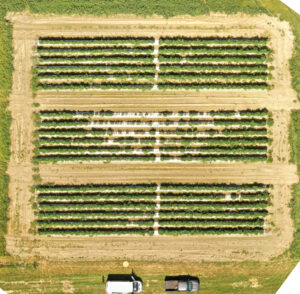Management of bacterial wilt on tomato
In 2022, our lab received funding from the NC Specialty Crop Block Grant Foundation to study the effects of soil alkalinization (raising the pH of the soil) on bacterial wilt of tomato. There is anecdotal evidence to suggest that raising the pH of field soil above 7.0 may reduce bacterial wilt on tomato, so we wanted to test this hypothesis ourselves.
In December of 2022, we applied lime to split-plots in a field with a history of bacterial wilt at the Mountain Horticultural Crops Research and Extension Center (MHCREC) in Mills River, NC. See a time-lapse of this process here.
We applied enough lime to raise the soil pH above 7.0, although we anticipate that it will take several years to change pH throughout the soil profile. We planted tomato cv. Mountain Fresh Plus in late June and waited for symptoms to develop. Our soil pH results from samples collected 4-8″ deep in the soil profile at planting showed an average of 6.9 for plots that we added lime to and 5.9 for those that no lime was added to. Symptoms of bacterial wilt became severe in late August and disease pressure was very high in some plots. Statistical analysis showed a difference in disease incidence between some plots that received lime and those that did not, however, we still need another year’s worth of data to back-up this year’s study. Soil samples collected 4-8′ deep in the soil profile after the final harvest showed an average pH of 7.0 in the lime-added plots and a pH of 6.0 in the no lime-added plots. Our lab is collaborating with Dr. Alejandra Huerta’s lab (located in Raleigh, NC) on this project, and they conducted a field trial similar to this one in 2023 in eastern North Carolina. Analysis of their results is underway. In the meantime, we are conducting experiments in the growth chamber and greenhouse to further investigate the role of soil pH and endemic microbial communities on bacterial wilt of tomato. We look forward to sharing more results in 2024!
